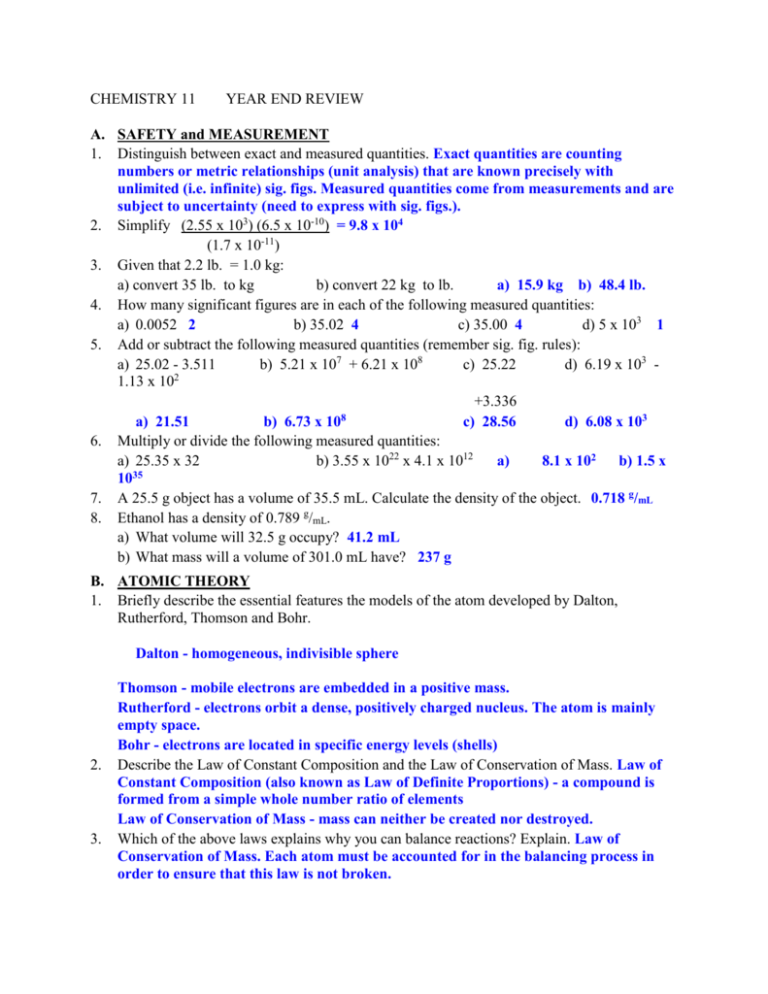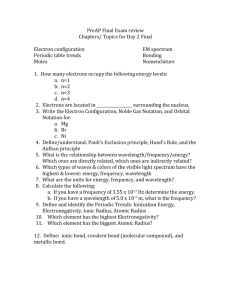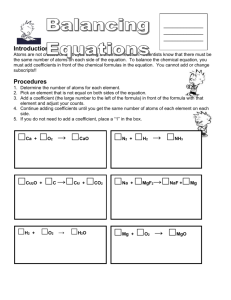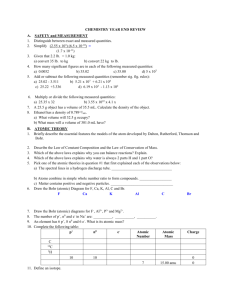Chemistry 11 Year End Review: Safety, Atoms, Compounds
advertisement

CHEMISTRY 11 YEAR END REVIEW A. SAFETY and MEASUREMENT 1. Distinguish between exact and measured quantities. Exact quantities are counting numbers or metric relationships (unit analysis) that are known precisely with unlimited (i.e. infinite) sig. figs. Measured quantities come from measurements and are subject to uncertainty (need to express with sig. figs.). 2. Simplify (2.55 x 103) (6.5 x 10-10) = 9.8 x 104 (1.7 x 10-11) 3. Given that 2.2 lb. = 1.0 kg: a) convert 35 lb. to kg b) convert 22 kg to lb. a) 15.9 kg b) 48.4 lb. 4. How many significant figures are in each of the following measured quantities: a) 0.0052 2 b) 35.02 4 c) 35.00 4 d) 5 x 103 1 5. Add or subtract the following measured quantities (remember sig. fig. rules): a) 25.02 - 3.511 b) 5.21 x 107 + 6.21 x 108 c) 25.22 d) 6.19 x 103 2 1.13 x 10 +3.336 8 a) 21.51 b) 6.73 x 10 c) 28.56 d) 6.08 x 103 6. Multiply or divide the following measured quantities: a) 25.35 x 32 b) 3.55 x 1022 x 4.1 x 1012 a) 8.1 x 102 b) 1.5 x 35 10 7. A 25.5 g object has a volume of 35.5 mL. Calculate the density of the object. 0.718 g/mL 8. Ethanol has a density of 0.789 g/mL. a) What volume will 32.5 g occupy? 41.2 mL b) What mass will a volume of 301.0 mL have? 237 g B. ATOMIC THEORY 1. Briefly describe the essential features the models of the atom developed by Dalton, Rutherford, Thomson and Bohr. Dalton - homogeneous, indivisible sphere 2. 3. Thomson - mobile electrons are embedded in a positive mass. Rutherford - electrons orbit a dense, positively charged nucleus. The atom is mainly empty space. Bohr - electrons are located in specific energy levels (shells) Describe the Law of Constant Composition and the Law of Conservation of Mass. Law of Constant Composition (also known as Law of Definite Proportions) - a compound is formed from a simple whole number ratio of elements Law of Conservation of Mass - mass can neither be created nor destroyed. Which of the above laws explains why you can balance reactions? Explain. Law of Conservation of Mass. Each atom must be accounted for in the balancing process in order to ensure that this law is not broken. 4. 5. 6. Which of the above laws explains why water is always 2 parts H and 1 part O? Law of Constant Composition (Definite Proportions) Pick one of the atomic theories in question #1 that first explained each of the observations below: a) The spectral lines in a hydrogen discharge tube. ________________________________ Bohr b) Atoms combine in simple whole number ratio to form compounds. _________________ Dalton c) Matter contains positive and negative particles. _________________________________ Thomson Draw the Bohr (atomic) Diagram for F, Ca, K, Al, C and Br. F Ca K Al C Br 7 e2 e- 7. 2 e8 e8 e2 e- 1 e8 e8 e2 e- 3 e8 e2 e- 9 p+ 20 p+ 19 p+ 13 p+ Draw the Bohr (atomic) diagrams for F-, Al3+, P3- and Mg2+. FAl3+ P38e2e- 8e2e- 8e8e2e- 4 e2 e- 17 e8 e8 e2 e- 6 p+ 35 p+ Mg2+ 8e2e- 9 p+ 9 p+ 9 p+ 9 p+ + 0 + 8. The number of p , n and e in Na are: __________, __________, __________.11p+, 12n0 and 10e9. An element has 6 p+, 8 n0 and 6 e-. What is its atomic mass? 14.00 amu 10. Complete the following table: p+ n0 eAtomic Atomic Charge Number Mass + 0 C 6p 6n 6e 6 12.00 amu 0 14 + 0 C 6p 8n 6e 6 14.00 amu 0 3 + 0 H 1p 2n 1e 1 3.00 amu 0 20Ne 10 10 0 10e 10 20.00 amu 15N + 0 7 15.00 amu 0 7p 8n 7e 11. Define an isotope. An isotope is one atom of an element. Most elements have more than one isotope. Each isotope of an element has a different mass but behaves in the same way chemically. They have different masses due to different numbers of neutrons but have the same number of protons. 12. Calculate the average atomic mass of magnesium given the following data: 24 13. 14. 15. 16. 17. 25 26 Mg 78.7% Mg 10.1% Mg 11.2% 24.33 amu Distinguish between a chemical family and a chemical period. Chemical family is a name given to a group in the periodic table e.g. noble gases while a period is a row of the periodic table. Describe what happens to the atomic mass and number as you move to the right within a period on the periodic table. As you move to the right within a period on the periodic table the atomic number increases as does the atomic mass. State three things that elements in the same chemical family have in common. Three things that elements in the same chemical family have in common - similar chemical reactivity, similar physical properties, and same outer (valence) electron structure. Circle each reactive atom or ion. a) Na b) Na+ c) S d) S2e) He The reactive species are: a) Na c) S; we know this because atoms want to acquire a stable octet of electrons, ions already have this … so atoms are more reactive! Complete the following chart. + Li Mg2+ S S2Ne p+ 3p+ 12p+ 16p+ 16p+ 10p+ n0 4n0 12n0 16n0 16n0 10n0 e2e10e16e18e10e- No. of valence e1 e8 e6 e8 e8 e- C. CHANGES IN MATTER 1. Define physical and chemical change. Physical change is a change in the state of matter of a chemical (or appearance) while a chemical change involves a change in the chemical structure (as a result of a chemical reaction which involves a rearrangement of atoms). 2. Circle each example of chemical change. a) iron rusts b) silver tarnishes c) ham is sliced d) water evaporates e) ice sublimes f) gasoline burns g) salt dissolves h) steam condenses i) water is converted into H2 and O2 The examples of chemical change are: a) iron rusts b) silver tarnishes f) gasoline burns i) water is converted into H2 and O2 . The rest are physical changes. 3. Define exothermic and endothermic change. Exothermic change involves the giving off or release of energy (usually heat) and endothermic changes involves the absorption of energy (heat). 4. Describe each a exothermic or endothermic. a) 2 H2 + O2 2 H2O + 500J exothermic b) 200 J + 2 KClO3 (s) 2 KCl + 3 O2 (g) endothermic c) H2O (s) H2O (g) endothermic d) H2O (g) H2O (l) exothermic 5. Define the following changes in state: evaporation, freezing, condensation, sublimation and melting. Evaporation: change from liquid to gas Freezing: change from liquid to solid Condensation: change from gas to liquid Sublimation: change from solid to gas OR gas to solid Melting: change from solid to liquid 6. At 100˚C determine the phase (solid, liquid or gas) for each of the following compounds: a) m.p. 20˚C b.p. 120˚C liquid b) m.p. 105˚C solid c) b.p. 25˚C gas 7. Define element, compound and mixture. Element: matter made up of only one kind of atom Compound: matter made up of two or more kinds of atoms. Mixture: matter composed of two or more different chemicals 8. Describe each as an element, compound or mixture. a) A homogeneous brown substance has a constant composition. After heating in a vacuum it gives off a gas and leaves a silver liquid. compound b) A homogeneous purple solid has a constant composition. After heating the solid in a vacuum it evaporates and re-condenses upon cooling. The molten solid does not decompose when an electrical current is passed through it. element c) A liquid has a boiling point of 105˚C. After boiling the liquid for 10 minutes, the boiling point changes to 110˚C. mixture 9. Define metals and nonmetals. Metals - a chemical element found on the left side of the periodic table. All are solid (except Hg), silver (except (Au and Cu), conduct electricity, shiney, form positive ions (cations). Nonmetals – a chemical element found on the right side of the periodic table. Can be solid, liquid or gas; can be colored or colorless, generally don’t conduct electricity, dull, form negative ions (anions). 10. Describe how you could separate a mixture of sand and water. Filter it. 11. Describe how you would separate a mixture of ethanol and water by distillation. Draw a labeled diagram of the apparatus used. In your explanation include the boiling points of water and ethanol and the terms: distillation flask, condensation tube and collecting flask. Distillation uses the differences in boiling point to separate two different chemicals (one boils at a lower temp than the other). The boiling point of water is 100˚C and ethanol is 78.5˚C, therefore ethanol will boil first and be collected in the collecting vessel after being condensed back into a liquid in the condenser. See page 28 in Heath Chemistry for the diagram. D. CHEMICAL COMPOUNDS 1. Circle each ionic compound. a) NaBr b) KOH c) HCl d) NH4C1 The ionic compounds are: a) NaBr b) KOH 2. Write correct ionic formula for each combination. a) Mg ; C1 b) NH4 ; O e) CH4 d) NH4C1 f) NH3 c) a) 3. Fe ; S d) A1 ; SO4 MgC12 b) (NH4)2O c) Name each compound in the above question. Fe2S3 d) A12(SO4)3 a) magnesium chloride b) ammonium oxide c) iron (III) sulphide d) aluminum sulphate 4. Define and give an example of a cation and anion. Cation (any positive ion) : Mg2+ Anion (any negative ion): Cl5. Circle each cation. a) K+ b) C1c) NaBr d) NH4OH + + + a) K c) Na d) NH4 6. Circle the formulas that have formula units. a) CCl4 b) H20 c) C12 d) NaF e) NH4Br d) NaF e) NH4Br 7. Circle the compounds that conduct electricity. a) Na (s) b) NaCl (s) c) NaCl (aq) d) NaCl (l) e) CCl4 (l) f) H2O (l) g) CH3OH (aq) h) NH4OH (aq) a) Na (s) (all metals conduct) c) NaCl (aq) (aqueous ionic compounds conduct) d) NaCl (l) (all molten or melted ionic substances) h) NH4OH (aq) (aqueous ionic compound) 8. Write dissociation equations for: a) Na2CO3 b) Fe2(SO4)3 + a) Na2CO3 (s) 2 Na (aq) + CO32- (aq) b) Fe2(SO4)3 (s) 2 Fe3+ (aq) + 3 SO42- (aq) 9. Draw Lewis structures for: a) CCl4 b) H2 c) CO2 d) C2H2 a) CCl4 b) H2 c) CO2 d) C2H2 10. Arrange the compounds into the four categories: ionic, acids, or molecular Na2SO4 H2SO4 CCl4 C2H6 KOH NH4OH CH3COOH NH4C1 Ionics: Na2SO4 NH4C1 KOH NH4OH Acids: H2SO4 CH3COOH Molecular: C2H6 CCl4 11. Explain why NaCl and CCl4 are stable compounds. NaCl and CCl4 are stable compounds because each element has a filled valence shell and does not want to lose or gain electrons or even share electrons with any other atoms. This makes them unreactive. 12. Circle the molecular compounds. a) H2O b) HCl c) NaBr d) NH4OH a) H2O b) HCl 13. Name each binary molecular compound. a) CCl4 b) CO2 SiCl a) carbon tetrachloride monochloride c) P2O5 d) b) carbon dioxide c) diphosphorus pentaoxide d) silicon E. REACTIONS 1. Complete, balance, and identify each reaction type. Write NR for those reactions that do not occur (use Activity Series to determine this - only for SR reactions). All phases must be included! a) C6H14 + O2 CO2 + H2O a) 2 C6H14 (g) + 19 O2 (g) 12 CO2 (g) + 14 H2O (g) hydrocarbon combustion b) Al2(SO4)3 + AgNO3 b) Al2(SO4)3 (aq) + 6 AgNO3 (aq) 2 Al(NO3)3 (aq) + 3 Ag2SO4 (aq) double replacement c) NaCl + KOH c) NaCl (aq) + KOH (aq) NaOH (aq) + KCl (aq) double replacement d) Au + Cu(NO3)2 d) Au (s) + Cu(NO3)2 (aq) NR single replacement e) Cu + Au(NO3)3 e) Cu (s) + Au(NO3)3 (aq) Cu(NO3)2 + Au (s) single replacement f) H2SO4 + NaOH f) H2SO4 (aq) + NaOH (aq) Na2SO4 (aq) + 2 H2O (l) double replacement g) HgO g) HgO (s) Hg (l) + O2 (g) decomposition h) Ca + H2 O h) Ca (s) + 2 H2O (l) Ca(OH)2 (s) + H2 single replacement (g) i) Al + I2 i) 2 Al (s) + 3 I2 (s) 2 AlI3 synthesis 2. Write a balanced chemical equation to show how solid iron reacts with oxygen from the air to produce solid iron (III) oxide. Include all phase symbols. 2 Fe (s) + 3 O2 (g) Fe2O3 (s) 3. Write a normal double replacement for Cu(NO3)2 (aq) + NaOH (aq). Write the total ionic and net ionic equations for this reaction. Cu(NO3)2 (aq) + 2 NaOH (aq) Cu(OH)2 (aq) + 2 NaNO3 (aq) Cu2+ (aq) + 2 NO3- (aq) + 2 Na+ (aq) + 2 OH- (aq) Cu(OH)2 (s) + (aq) Cu2+ (aq) + 2 OH- (aq) Cu(OH)2 (s) F. MOLE CONCEPT 2 Na+ (aq)+ 2 NO3- 1. 2. 3. 4. 5. 6. 7. 8. 9. 10. 11. 12. 13. 14. 15. State Avogadro’s number and hypothesis. Avogadro’s number is 6.02 x 1023 Define molar mass. Molar mass is the mass of one mole of a chemical. If 3.50 moles of an element has a mass of 14.0 g, calculate its atomic molar mass. What is the element? 4.00 g/mol. The element is He Calculate the number of moles in 50.0 L of H2 (g). 2.23 mol of H2 (g) Calculate the number of grams in 35.2 moles of cobalt. 2.074 x 103 g Calculate the number of atoms in 6.25 moles of copper atoms. 3.76 x 1024 atoms Calculate the number of moles of water molecules that is equal to 7.55 x 1022 molecules of water. 0.125 moles of water. Calculate the number of formula units of NaCl in 5.60 g of NaCl. 0.0958 moles or 5.77 x 1022 formula units. Calculate the mass of 2.65 x 1027 atoms of iron. 2.46 x 105 grams of iron. Calculate the percent composition of each element in C2H6O. C = 52.13% H = 13.15% O = 24.72% A compound is 32.38% Na, 22.58% S and 45.07% O. Calculate the empirical formula of the substance. Check your formula with the table of radicals. Na2SO4 What is the empirical formula of C6H6? CH A molecular compound has an empirical formula of CH2 and a molecular mass of 84 g/mol. Determine the molecular formula. C6H12 How many moles of H2 gas at STP are in 100.0 L? 4.464 moles of H2 gas at STP are in 100.0 L How many litres of NH3 gas at STP are in 2.5 moles? 56 L of NH3 gas G. BONDING 1. Draw an ionic crystal lattice for NaCl. 2. Explain how two atoms bond ionically. Explain how two atoms bond covalently. Illustrate your answers with examples. 3. What does electronegativity refer to? Electronegativity is a relative number that expresses an atoms desire for electrons. The higher the number the greater the desire. (Useful to determine the polarity of bonds) 4. Find the electronegativity of the following atoms from your periodic table: Na, F, Br, S, O, Ca, Fr, Cu. Na = 0.9, F= 4.0, Br = 2.8, S= 2.5, O=3.5, Ca = 1.0, Fr = 0.7, Cu = 1.9 5. Draw the Lewis and structural diagrams of the following molecules. State their shape if they are linear or bent (angular). Determine whether they are polar or not. a) Cl2 b) C2Cl2 c) PH3 d) HCN e) CCl4 f) H2O g) CH3OH h) N2H4 a) C2H4 b) C2H5Cl Some need rule 5. a) Cl2 b) C2Cl2 c) PH3 d) HCN linear linear linear Triple bonded Triple bond C-N e) CCl4 6. 7. 8. f) H2O angular j) C2H5Cl g) CH3OH h) N2H4 Ns Double bonded i) C2H4 double bond Describe the three kinds of intermolecular forces and provide drawings to illustrate. London Dispersion Forces - found between all molecules. It is the force of attraction of one molecules protons and other molecules electrons. The greater the number of electrons the greater the LDFs Dipole-Dipole Forces - the force of attraction between the charges ends of molecules that are polar (positive ends of one molecule attracted to the negative end of another). Only found with polar molecules. Hydrogen Bonding - the very strong polar interaction between molecules that are highly polar. Must have one of the following covalent bonds in the molecule: O-H, N-H, F-H. What does the term isoelectronic mean? Isoelectronic means the same number of electrons. Used in compare the intermolecular forces between two chemicals OR to describe the stability of electron structures of ions (ions are isoelectronic with nearest noble gases). Explain why CH4 has a much lower boiling point than H2O (they are isoelectronic chemicals!) CH4 has a much lower boiling point than H2O since it is subject to only London Dispersion forces while there are other intermolecular forces between the water molecules. Since these chemicals are isoelectronic they have the same relative amount of LDF but the polarity of the water molecule with its O-H bond gives it hydrogen bonding as well as dipole-dipole forces. Water has therefore, three intermolecular forces to methane’s one. H. PERIODIC TABLE 1. Draw an outline of the periodic table and indicate where each chemical family is located. State where the metals and nonmetals are located. Describe the trends of ionization energy and atomic radius. 2. State what is meant by ionization energy and provide an equation to show the ionization of Ca atoms. Ionization energy is the energy required to cause a neutral atom to become a positive ion (or the energy required to make the atom lose one electron and become a positive ion). Ca (g) Ca+ (g) + 1 e3. Which is larger metal atoms or metal ions. Explain. Metal atoms are larger than metal ions because metal ions have lost electrons and, as a result, no longer have the original valence shell that the electrons were located in. 4. Which is larger nonmetal atoms or nonmetal ions. Explain. Nonmetal ions are larger than nonmetal atoms because these ions have gained electrons to fill up their valence shells. The extra electrons force electrons that exist in the valence shell to move outward a little to minimize electron-electron repulsions. 5. 6. I. 1. 2. 3. 4. 5. 6. 7. 8. 9. J. 1. 2. 3. 4. 5. 6. 7. In which chemical family is each element located? Cl, K, U, Ca, Xe, Fe, Ru, Lw Cl = halogen, K = alkali metal, U = actinide series, Ca = alkaline earth, Xe = noble gas, Fe = transition element, Ru = transition element, Lw = actinide series State the periodic law.The Periodic Law states that if the elements are arranged in order of increasing atomic mass, a pattern can be seen in which the properties reoccur on a regular basis. STOICHIOMETRY How many chlorine atoms are in 5 formula units of MgCl2? 10 Cl atoms How many moles of Br are in 10.0 moles of AlBr3? 30.0 moles Given the reaction: 2 H2 + O2 2 H2O How many moles of H2O are produced by a) 5 moles O2 and b) 5.0 g O2 ? a) 10 moles H2O b) 0.63 moles H2O If the actual yield is 50.0 g and the theoretical yield is 70.0 g, what is the percentage yield? 71.4% Given: 2 Fe2O3 + 3 C 4 Fe + 3 CO2. If 50.0 g of Fe2O3 completely reacts with excess carbon, how many grams of carbon dioxide are produced? 20.7 g of CO2 C3H8 (g) + 5 O2 (g) 3 CO2 (g) + 4 H2O (g). If 205g of C3H8 (g) reacts with excess O2 (g), calculate the theoretical yield of CO2 (g). If the actual yield of CO2 was 500.0 g, calculate the percentage yield. 614 g of CO2 (g). The percentage yield would be 81.4%. 2 H2 (g) + O2 (g) 2 H2O (l) How many grams of H2O are produced when 50.0 L of H2 (g) at STP reacts completely to form water. 40.2 g 2 NaCl 2 Na + Cl2. How many litres of Cl2 (g) are produced at STP when 100.0 g of NaCl completely react. 19.16 L of Cl2 (g) 2 H2 (g) + O2 (g) 2 H2O (l) If 8 moles of H2 (g) reacts with 3 moles O2 (g), determine the amount (moles) of H2O (l) produced, the limiting reactant and the amount of excess reactant. Mole of H2O (l) produced 6 moles. The limiting reactant is O2 (g).The amount of excess reactant is 2 moles. SOLUTION CHEMISTRY Pick the compounds that would be soluble in CCl4. a) NaCl b) CBr4 c) C2H2 d) HF e) H2O b) CBr4 c) C2H2 d) HF (Rule is “like dissolves like” which means that polar liquids will dissolve polar chemicals while nonpolar will dissolve nonpolar). Calculate the number of grams NaCl required to prepare 100.0 mL of a 0.200 M solution. 1.17 grams NaCl Calculate the number of litres of NaCl required to obtain 0.50 g if the solution is 0.20 M. 0.043 L How many moles NaCl are in a 0.20 L of a 0.50 M solution. 0.10 moles 25.0 moles NaOH is dissolved in 50.0 L of H2O. What is the molarity? 0.500 M If 25.0 g NaOH is dissolved in 5.0 L of H2O, what is the concentration? 0.125 M If 25.0 mL of a 6.0 M NaOH solution is diluted to 100.0 mL, what is the new molarity? 1.5 M 8. You are given the equation H2SO4 + 2 NaOH Na2SO4 + 2 H2O and that 50.0 mL of 0.20M NaOH is required to neutralize 25.00 mL H2SO4. What is the acid concentration? 0.20 M K. ORGANIC CHEMISTRY 1. Name each organic structure a) methylbutane (the 2 is not needed) b) 3-ethylhexane c) 3-methyl-2-ethylpentane d) 1-bromo-2,2-dichlorobutane e) f) g) 1-fluoro-3-methylbutane 3-methylpentane 2-methyl-4-ethylhexane h) 1,3-dibromo-4-chloro-5-methyloctane 2. Draw the structural formula for each organic chemical. a) 1,1-dibromopentane b) 3,3,4 - trimethylhexane c) 4-ethyl-5-methyldecane d) trans-2-hexene e) 4-octyne f) cyclohexane g) 2-methyl-4-chloro-3-octene cis or trans structure OK. 3. Draw all of the isomers of C5H12.





